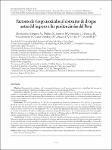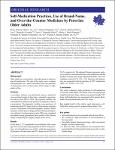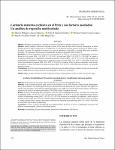Risk factors associated with drug use before imprisonment in Peru [Factores de riesgo asociados al consumo de drogas antes del ingreso a las penitenciarías del Perú]

Ver/
Descargar
(application/pdf: 86.32Kb)
(application/pdf: 86.32Kb)
Fecha
2018-01-01Autor(es)
Hernandez Vásquez, Akram
Núñez, S.
Santero, M.
Grendas, L.
Huarez, B.
Vilcarromero, S.
Casas-Bendezú, M.
Braun, S.
Cortés S.
Rosselli, D.
Metadatos
Mostrar el registro completo del ítemResumen
ABSTRACT
Objective: To assess the prevalence of drug abuse before prison admission and to identify associated sociodemographic and family history risk factors, according to gender, in prisons of Peru. Materials and methods: A secondary analysis was carried out with data from the First National Prisoner Census 2016, using a questionnaire of 173 items that was applied to the whole prison population of Peru. The types of drugs used before admission were analyzed according to characteristics of the penitentiary population, and generalized linear models were used to calculate prevalence ratios with 95% confidence intervals to identify possible factors associated with drug use. Results: Out of a population of 76,180 prisoners, 71,184 (93.4%) answered the survey (men 67,071, 94.2%). The overall prevalence of drug consumption before admission was 24.4% (25.3% in men and 9.1% in women), the highest prevalence in the 18-29 age group (36.3% in men and 14.9% in women). The most commonly used drugs were marijuana (58.2%), coca paste/cocaine or crack (40.3%) and inhalants (1%). The factors most strongly associated with consumption were having a family member who consumed drugs (59.8%), history of previous imprisonment (59.1%), unemployment (48.4%), relationships at school with classmates who had problems with the law (46.9%), background of a family member who attended a penitentiary (38.4%), and history of running away from home before age 15 (35.9%). Conclusions: In Peru, drug use is higher in the prison population than in the general population, and there are differences according to sex in the prevalence of drug use and associated factors prior to admission to a prison. The study demonstrated that childhood events, such as child abuse, having a family member imprisoned, having a family member who used drugs, or who previously abused alcohol, are factors associated with drug use in the penitentiary population. Some of these risk factors are modifiable, so it is important to consider these in the design of social and health policies focused on specific subpopulations to prevent drug use and crime.
Mostrar más
Cita bibliográfica
Hernández, A. ...[et al]. (2018). Risk factors associated with drug use before imprisonment in Peru [Factores de riesgo asociados al consumo de drogas antes del ingreso a las penitenciarías del Perú]. Revista Española de Sanidad Penitenciaria, 20(1), 12-22. http://www.sanipe.es/OJS/index.php/RESP/article/view/488
Colecciones
El ítem tiene asociados los siguientes ficheros de licencia:
Excepto si se señala otra cosa, la licencia del ítem se describe como info:eu-repo/semantics/openAccess
Ítems relacionados
Mostrando ítems relacionados por Título, autor o materia.
-
Self-Medication Practices, Use of Brand-Name, and Over-the-Counter Medicines by Peruvian Older Adults
Herrera Añazco, Percy; Mougenot, Benoit; Benites Meza, Jerry K.; Barturén Alvarado, Luz C.; Zumarán Nuñez, Carlos J.; Boyd Gamarra, Maria A.; Runzer Colmenares, Fernando M.; Benites Zapata, Vicente A. (Canadian Geriatrics Society, 2023-03-02)Acceso abiertoBackground Older adults are a particularly vulnerable group to drug use and self-medication. The aim of the study was to evaluate self-medication as a factor associated with the purchase of brand-name and over-the-counter ... -
Association between self-medication with antibiotics and purchase of brand-name drugs: Analysis of a national survey in Peru
Benites Meza, Jerry K.; Herrera Añazco, Percy; Santillán Rodríguez, Arón A.; Zumarán Nuñez, Carlos J.; Barturén Alvarado, Luz C.; Benites Zapata, Vicente A. (Oxford University Press, 2023-04-24)Acceso cerradoObjectives To determine the association between self-medication with antibiotics (SMA) and purchase of brand-name drugs in Peru. Methods A secondary analysis was conducted using a nationally representative survey from ... -
Exclusive breastfeeding in Peru and its associated factors: A multivariate regression analysis [Lactancia materna exclusiva en el Perú y sus factores asociados: Un análisis de regresión multivariado]
Aucca Chacon, Marcia Milagros; Santos Rosales, Yuly R.; Correa Lopez, Miriam Yoana; Mayta Tovalino, Frank; Barja Ore, John (Sociedad de Obstetricia y Ginecologia de Venezuela, 2023-05-09)Acceso abiertoObjetivo: Determinar la prevalencia y factores asociados de la lactancia materna exclusiva en el Perú. Métodos: Estudio analítico transversal, realizado a partir de las bases de datos de la Encuesta Demográfica de Salud ...





